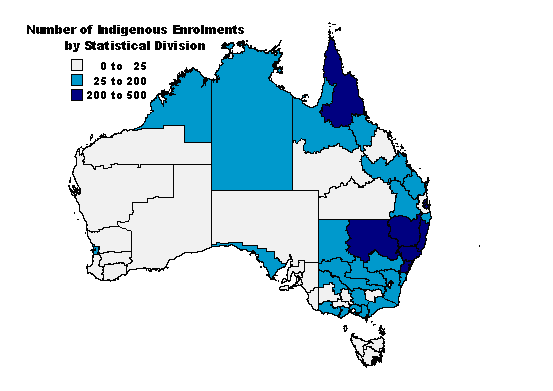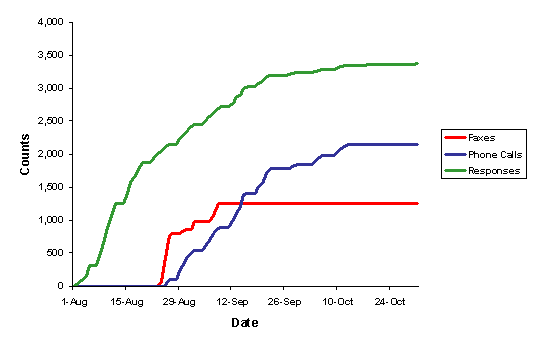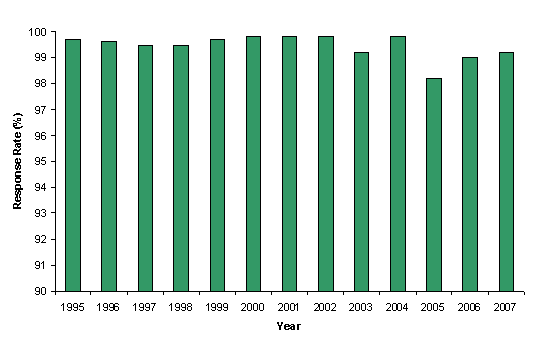When is a Response Rate of 95% Not Enough?
Overview
The Problem:
How to measure progress on the participation of Indigenous children in preschool education across Australia
The Data Analysis Australia Approach:
To develop a methodology that included multi-mode response mechanisms and intensive follow up of late respondents having identified from the start that non-response and incomplete information were key issues in this area.
The Result:
Data Analysis Australia has conducted the National Preschool Census (formerly the National Aboriginal and Torres Strait Islander Preschool Census and the National Indigenous Preschool Census) annually since 1993 (with the exception of 1994), achieving response rates of well over 95%.
Background
Access to education has long been seen as an issue for Australia's Indigenous population and educational disadvantage often starts with children not attending preschools. In 1994 the Commonwealth Government began a four-year program to provide additional funding to preschool education providers to assist them achieve improved educational opportunities and outcomes for Indigenous people. To monitor the effectiveness of this initiative, the then Department of Education, Employment and Training needed to obtain accurate data on preschool participation rates of Indigenous children across Australia on an annual basis, beginning in 1993 to establish a baseline.
The Problem

Preschool education in Australia is the responsibility of States and Territories, not the Commonwealth, and as such preschool education delivery arrangements are characterised by remarkable diversity. While most State and Territory Education Departments collected information from Government preschools, this needed to be collated and there was little information available regarding non Government preschools. A data collection methodology that could be implemented successfully in all States and Territories had to be developed.
The key issue faced was possible non-response. It was likely that non-response would be highest for non-Government preschools in remote areas, precisely the preschools most likely to have Indigenous children, as can be seen from the map. Hence even a small non-response rate had the potential to give substantial biases. This problem is often termed "non-ignorable non-response".
The challenge was therefore to maximise the response rate where it was the most difficult. At the extreme, some of these preschools are in remote communities services by only a single telephone line and irregular mail deliveries.
The Data Analysis Australia Approach
As one of the uses of the data to be collected was to allocate initial levels of funding for individual preschools, a sample survey approach would not be adequate. Since many Indigenous children live in remote areas of Australia, Data Analysis Australia realised that data collection from preschools with Indigenous enrolments was likely to be more difficult than from those without any, and a sample survey would therefore be likely to have a higher level of non response from preschools with Indigenous students, leading to biased results. Some of the reasons for the expected differential response rates were:
- Preschools with Indigenous students were more likely to be remote and hence more likely to have problems with mail and telephone services; and
- Preschools with Indigenous students were to be asked to provide additional information about these students, resulting in increased respondent burden.
Therefore, the data collection was conducted as a Census (the National Aboriginal and Torres Strait Islander Preschool Census), a complete count rather than as a sample survey. The Census consists of two separate collections:
- Data collected by State and Territory Education Departments from Government preschools, covering approximately 1,500 preschools; and
- Data from individual non-Government preschools from all States and Territories, covering approximately 3,500 preschools.
Due to the compulsory nature of the Government data collections, response rates are not an issue for this side of the Census. However completing the Census is not compulsory for non-Government preschools and non-ignorable non-response is therefore an issue. In order to overcome this issue and ensure an almost 100% response rate, a number of different return options are provided to preschools and intensive follow up of non responding preschools is undertaken.
Following each year's implementation, Data Analysis Australia reviews the Census procedures and makes recommendations for changes if appropriate. This has led to the use of a number of additional response and follow up mechanisms over the years, as technology has developed. The current multi mode response mechanisms offered are:
- Mail back in a reply paid envelope, which is provided with the Census form, or in a standard envelope to the reply paid address if the reply paid envelope has been misplaced;
- Fax back to a toll free number;
- Email back (a Census form can be emailed to the preschool on request); or
- Telephone interview to a toll free number.
With more and more preschools now having Internet access, Data Analysis Australia has discussed the provision of an on line version of the Census form with the Department and this option is currently under consideration. However this is seen as a supplement to existing modes, not a replacement.

The intensive follow up procedures include automated fax reminders with an attached copy of the Census form, plus a second one-page reminder without the Census form. In a typical year between 1,000 and 1,500 automated fax reminders will be successfully sent. However the main follow up method remains the telephone, at which stage other response mechanisms such as fax and email are also offered.
Whilst telephone follow up for standard market research sample surveys tends to be limited to three or four attempts per number, we recognised that adopting this approach would be unlikely to overcome the bias against preschools with Indigenous students.
Therefore the number of call attempts per preschool are not limited for preschools that are likely to have Indigenous enrolments - the results of previous Censuses are tracked for each preschool to enable us to identify preschools that are likely to have Indigenous enrolments. Up to six call attempts are made for other preschools - generally resulting in over 2,000 outgoing calls.

While more than half of the preschools included in the Census respond within the first few weeks, requiring no follow up, a large proportion of the follow up effort is spent on a relatively small number of returns. This can be seen in the accompanying chart showing the progress of completed responses against follow up effort for a typical year. What can't be seen from this chart is that these hard to get returns are typically the most critical.
The Result
The Census, now known as the National Preschool Census, has been running successfully for over fifteen years. As can be seen from the chart, response rates of well over 95% have been maintained despite changes that have increased the amount of information collected from all preschools.
December 2008
